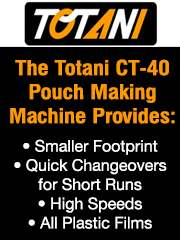"Partnering" helps get press up to speed
- Published: December 01, 1995, By Mykytiuk, Andrew
Viking Label and Packaging faced production delays with ink foaming problems until DIP Co. stepped in and gave its partner a helping hand.
When Viking Label and Packaging Inc., Nisswa, MN, tested its new flexo press at low speeds, everything seemed to be working fine. However, when operators began running at a production speed of 200 fpm, the ink fountains foamed up and quickly overflowed. Viking solved the problem and got the press up to speed with the help of DIP Co., Bloomington, MN, a supplier of inking systems and a trusted Viking vendor and "partner."
The 10-in., six-color, flexographic press was custom-designed for Viking by Flexo-Accessories/Propheteer, Palatine, IL. Plant manager Terry Giles and other key Viking employees worked closely with Propheteer engineers to design a press that would print on polystyrene and lay down six colors simultaneously at 200 fpm. The PS used is from Plastic Suppliers Co. (Viking also runs MACTac's chrome coat 640). Typically, when foaming problems occur, the operators stop the press, check the fountains and controls, and make sure everything is set up correctly. Viking personnel followed this procedure, but the problem remained.
Hitting a Snag
Viking is a major player in the label printing arena, shipping its product to 45 states and employing 43 people working two shifts. The company operates six flexographic presses: three Allied Gear 10-in. models (one five-color, one four-color and one three-color); two Allied Gear 7-in., two-color presses; and the Propheteer 10-in. Also in use are two Sanki seven-color, 10-in., ultraviolet rotary letterpresses. An in-house graphics department includes an Agfa Proset 9550 Imagesetter and the latest in computer hardware and software, scanners, a Kelleigh plate-making system and Hewlet Packard color proofing equipment.
Viking was counting on the new press to deliver a huge just-in-time order to a major manufacturer. The job, to be printed on matte, clear PS, was complicated. It first required the laydown of an opaque color, followed by the laydown of four additional colors and the printing of fine type. An FDA-approved overcoat would be put down over all of this. The five colors were to be changed frequently, depending on the requirements of the specific food label.
In order to meet production deadlines, it was absolutely necessary for Viking to run the labels at 200 fpm, but the combination of the speed and the viscosity of the inks being run was causing the foaming problem and creating a condition that necessitated constant stopping and frequent cleanups.
Giles and his assistants determined that a level controlling the ink pan combined with improved journal/anilox wipers would solve the overflow problem, but they didn't have the luxury of time to experiment. The problem, which could not have been foreseen when the press was being designed, had to be solved, and it had to be solved quickly. The company's 30-year reputation of on-time order fulfillment was at stake. "We built our reputation by performing special jobs, by doing them fast, and by not sacrificing quality," says Giles.
Pioneers in Partnering
Ed Decker started Viking Label and Packaging 30 years ago in a small concrete building with a 4-in. Mark Andy press. As business grew he purchased several more 4-in. presses and eventually a 6-in. model, all from Mark Andy. In 1983 Viking expanded into UV rotary letterpress with a Sanki seven-color press, only the second such press sold in the US.
Decker retired in 1991, selling the business to Tom Wetrosky and Don Engen. The new owners brought in a management network that included quality control, production and rewind departments. They updated presses and began to change the marketing focus. "Originally we thrived on many smaller accounts," says Steve Engen, Viking's general manager. "The new focus was on attracting the larger, more stable customer."
To handle the expected increase in business, and to continue providing its current customers with the service they were accustomed to, Viking upgraded the three 10-in., flexographic presses as well as a Superior embossing machine and an Onda hot stamping press. The company has more than 1,000 dies in its die library, most of them from Rotometrics.
While "partnering" is an industry buzzword today, Ed Decker practiced the concept since day one, and, to Wetrosky and Engen, it's the only way to grow a successful business. So, it was not surprising that Viking called upon one of its partner/vendors, the DIP Co., to help solve the perplexing foaming problem.
Viking Label and Packaging, which serves as a beta site for several equipment manufacturers, was aware that DIP was putting the finishing touches on products specific to the Propheteer and offered to let DIP use its new press as a test bed for its patented ink control products if DIP would help Viking solve its foaming mystery.
With DIP disposable ink trays and ink fountains, the operator runs the job, drains the ink, cleans the rollers and starts the next job with a new paper fountain. The paper fountain is mounted in a stainless steel carrier or retainer that replaces the traditional all-metal fountain. The paper ink fountains are made of bleachboard that is 20 mils thick, about the thickness of a cardboard cereal box. The paper is coated with a polyethelyne barrier so it's resistant to all UV and solvent-based inks as well as to the Werneke water-based inks in use at Viking.
Serious but Solvable
Giles' first thought was to utilize DIP's disposable paper ink trays to handle the ink overflow. Mark Thompson, president of DIP Co., looked at the situation and discovered that Viking had a more serious problem than was originally suspected. His first discovery was that the ink fountains were too small; they would have to be increased in size to support the 200-fpm speeds. DIP engineers, working in conjunction with Giles and his staff, fabricated a prototype retainer and paper fountain for testing.
After some quick calculations and experimentation, the team constructed a set of prototype metal retainers and disposable paper fountains that, in theory, were just the right size. In order to ensure that the problem did not occur again, DIP engineers designed and built a special clip that they welded onto the retainer. All the press operator had to do was flip it up, place a wiper sponge into position, drop the clip in place, and the press was ready to run.
With the deadline upon them, Viking operators crossed their fingers and started up the press. It ran perfectly the first time! At speeds of 200 fpm, there was no evidence of foaming or overflow.
"Not only can we run the press at higher speeds, but we also save a tremendous amount of time during cleanup and ink changes," reports Giles. "By utilizing the disposable ink fountains, we now take one-third the time for cleanup and one-half the time for ink changes. Time savings like these allow us to maintain the tight scheduling that we need to meet our customers' needs. The partnership we have developed with Mark Thompson and the DIP Co. has been very beneficial to our organization."
Viking Label and Packaging, which serves as a beta site for several equipment manufacturers, weathered the crisis that threatened the company's on-time reputation. Viking was once again reminded that no one is in this business alone, and help from a partner is just a phone call away.













